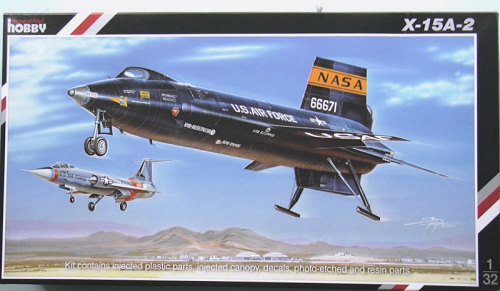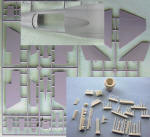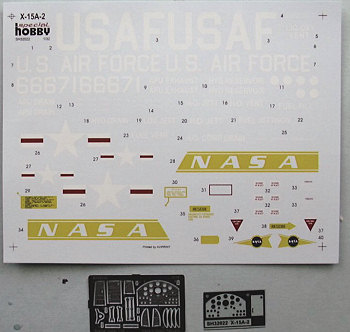
| KIT: | Special Hobby 1/32 X-15A-2 |
| KIT #: | 32022 |
| PRICE: | $ |
| DECALS: | One option |
| REVIEWER: | Tom Cleaver |
| NOTES: |

| HISTORY |
Following his record-making flight in the Douglas D-558-2 “Skyrocket,” in which he became the first man to fly at Mach 2, test pilot Scott Crossfield knew he’d been lucky to survive the flight, since he had gone well beyond the aerodynamics of the airframe, which had only been designed for flight up to about Mach 1.4. Crossfield believed that something had to be done to get experimental aircraft into existence that were sufficiently advanced that they would not be obsolete before they had completed their test program. Something had to be built and built fast for research into hypersonic flight. Crossfield was so insistent on this that he resigned as Chief Test Pilot for NACA at Edwards Flight Test Center, and went to work at North American, where there was interest in developing the next generation of experimental airplane, which everyone knew should become the first space plane.
North American presented their ideas to NACA in the summer of 1954, and the original Request for Proposals was issued for the airframe 30 December 1954 - approximately one year after Crossfield’s record flight in the D-558-2. North American received the airframe contract in November 1955, with Reaction Motors contracted in 1956 to build the engines. To save time, it was decided that the initial model of what was now known as the X-15A would be powered by two already-existing XLR-11 rocket engines , delivering 8,000 lb of thrust. This would allow initial testing of the airframe until the "real" engine - a single XLR-99 that delivered 57,000 lb thrust at sea level, and 70,000 lbs of thrust at peak altitude. It was believed the XLR-99 would be ready within two years of first flight.
The result was the North American X-15 rocket plane, which established numerous speed and altitude records in the early 1960s, flying to the edge of space as the first manned suborbital spacecraft ever constructed by the United States. During the X-15 program, 13 flights by eight pilots met the USAF's criteria for a spaceflight by passing an altitude of 50 miles, and the pilots were accordingly awarded astronaut status by the USAF. Two flights - by the same pilot - also met the international FAI definition of a spaceflight by passing the 62.1 mile (100 km) mark. Some respected researchers place the threshold of space at lower altitudes than do the USAF, NASA, and the FAI, meaning that many X-15 pilots could be considered astronauts.
Three X-15s were constructed. They flew 199 flight tests, the last on October 24, 1968. Twelve pilots flew the X-15s, including Neil Armstrong - the first man to step foot on the Moon - and Joe Engle, who commanded Space Shuttle missions 20 years later. In July and August 1963, Joe Walker flew higher than 100 km altitude mark twice, becoming the first person to enter space twice. A 200th flight was to have been launched over Smith Ranch, Nevada on November 21, 1968 with William J. Knight as the pilot. Technical and weather delays caused the mission to slip six times until it was finally canceled altogether on December 20, 1968 due to weather.
The first X-15 is on display at the National Air and Space Museum in Washington, DC. The second X-15 was rebuilt after a landing accident and lengthened 2.4 ft (0.74 m); using a pair of auxiliary fuel tanks and a heat-resistant surface treatment, the X-15A-2 set a record of 4,520 mph; it is now displayed at the National Museum of the United States Air Force at Wright-Patterson Air Force Base. The third X-15, 56-6672, was destroyed in a crash on November 15, 1967, when the airplane began to spin during descent and disintegrated when acceleration reached 15 Gs, scattering wreckage over 50 square miles. The flight had attained an altitude of 266,000 feet (81.1 km).
The altitudes records set by the X-15 remained unsurpassed by any piloted aircraft except the Space Shuttle until the third spaceflight of SpaceShipOne in 2004.
| THE KIT |
 Over the years there have been several kits of the X-15 released. The first was
a “box scale” kit from Revell that I recall building as a child. There have
been a couple of 1/7
Over the years there have been several kits of the X-15 released. The first was
a “box scale” kit from Revell that I recall building as a child. There have
been a couple of 1/7 2 kits whose
manufacturers and release dates I do not recall, (Monogram and Special Hobby.
Ed) and a 1/48 kit released by Special Hobby in about 2002. This is the first
kit of this famous aircraft in 1/32 scale.
2 kits whose
manufacturers and release dates I do not recall, (Monogram and Special Hobby.
Ed) and a 1/48 kit released by Special Hobby in about 2002. This is the first
kit of this famous aircraft in 1/32 scale.
The 1/48 kit, also done by Special Hobby, has a reputation as a “bear” to build, with numerous fit problems. MPM representatives at this year’s IPMS-USA Nats were questioned by modelers about the fit of this kit, and said they had solved the problems. Initial test-fitting of the parts here shows that it will go together with no more problem than one usually associates with a limited-run kit.
There is nice surface detail, including the “scallops” on the fuselage side extensions that I haven’t seen before on any X-15 kit. The cockpit looks to be detailed enough, and the landing gear is provided in detailed resin pieces. The decals are for the second X-15, the first to fly with the XLR-99 “big engine,” the exhaust of which is provided here as a resin part. The NASA insignia is in yellow only, requiring a modeler to paint the white backing; this is as good a way as any to insure the proper yellow color, which could be difficult to apply as a yellow and white decal over a black surface.
| CONCLUSIONS |
This kit looks simple, with an effective production design that should (hopefully) ease assembly. The X-15 is surprisingly small, even in this larger scale, so those interested in X-planes should have no problem finding space for it on the shelf when completed.
Review kit provided by Special Hobby.
August 2007
If you would like your product reviewed fairly and quickly by a site that has around 400,000 visitors a month, please contact me or see other details in the Note to Contributors.